Michigan 2018 Annual Report
You also want an ePaper? Increase the reach of your titles
YUMPU automatically turns print PDFs into web optimized ePapers that Google loves.
An amendment to an amendment is a motion to modify<br />
the wording of the proposed amendment and is made<br />
as follows: “I move to amend the amendment<br />
by....” The same forms for making an amendment are<br />
applicable for making a secondary amendment.<br />
The motion to commit or refer is generally used to<br />
send a pending motion (also called “the question”) to<br />
a small group of selected persons - a committee, board,<br />
or cabinet, for example - so that the question may be<br />
studied and put in better condition for the assembly<br />
to consider. The motion is stated: “I move to commit<br />
the question to..........for further study.”<br />
The motion to close a debate (previous question), if<br />
seconded and approved by a two-thirds vote, stops<br />
discussion on the pending question and is stated: “I<br />
move the previous question.”<br />
A division of the assembly may be called by any<br />
member if the chair’s decision on a voice vote is in<br />
question. The member proceeds to the microphone<br />
and states: “I call for a division of the house.” The<br />
chair then takes a standing or roll call vote.<br />
A division of the question may be called when<br />
a pending motion relates to a single subject but<br />
contains several parts, each capable of standing as<br />
a complete proposition. The parts can be separated,<br />
and each considered and voted on as a distinct<br />
question. The motion is stated: “I move to divide<br />
the question........as follows....”<br />
The motion to reconsider enables a majority of the<br />
assembly to bring back for further consideration a<br />
motion that has already been voted. The purpose of<br />
reconsidering a vote is to permit correction of hasty,<br />
<strong>2018</strong> ANNUAL REPORT<br />
ill-advised, or erroneous action, or to consider added<br />
information or a situation that has changed since the<br />
vote was taken. (Note exception on the Table - Rules<br />
Governing Motions)<br />
Parliamentary inquiry is a question directed<br />
to the presiding officer to obtain information on<br />
parliamentary law or the rules of the organization<br />
as relevant to the business at hand. A member<br />
addresses the chair and states: “I rise to a (point)<br />
of parliamentary inquiry.”<br />
Point of information is a request, directed to<br />
the chair or through the chair to another officer or<br />
member for information relevant to the business and<br />
hand. The request is not related to parliamentary<br />
procedure. The member addresses the chair and<br />
states: “I rise to a point of information.”<br />
The motion to appeal the decision of the chair is<br />
made at the time the chair makes a ruling. If it is made<br />
by a member and seconded by another member,<br />
the question is taken from the chair and vested in<br />
the voting body for a ANA-<strong>Michigan</strong> decision. The<br />
motion is stated: “I move to appeal the decision<br />
of the chair.”<br />
Before a member can make a motion or address the<br />
assembly on any question, it is necessary that he<br />
or she obtain the floor through recognition by the<br />
presiding officer. The member must:<br />
• rise and proceed to the microphone.<br />
• address the chair by saying, “Madam<br />
Chairperson”<br />
• await recognition<br />
• give name and region<br />
• state immediately the reason for rising<br />
Rules Governing Motions<br />
___________________________________________________________________________________________________________<br />
Interrupt Speaker Recognized by Chair Requires a Second Debated Vote<br />
Main motion NO YES YES YES Majority<br />
Amendment NO YES YES YES Majority<br />
Amendment to amendment NO YES YES YES Majority<br />
Limit Debate NO YES YES NO Two-thirds<br />
Close debate (previous quest.) NO YES YES NO Two-thirds<br />
Divide the Question NO YES YES NO Majority<br />
Reconsider NO YES YES YES Majority*<br />
Point of parliamentary inquiry YES NO NO NO Chair Decides<br />
Point of Information YES NO NO NO Chair Decides<br />
*Majority vote except when the motion being reconsidered required a two-thirds vote for its passage; then the motion to<br />
reconsider requires a two-thirds vote.<br />
11

















